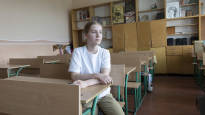BORYSLAV/HELSINKI
A crack of fresh paint floats in the air. A school in a small town in western Ukraine is being renovated hard ready for the coming school year.
Above the main entrance in the lobby is a plaque that reminds of the ongoing war. The plaque honors a former student of the school who died in the war.
Four more tiles will be attached soon, says the vice-principal Lyudmila Kinderys.
– When the children go back to school, we attach commemorative plaques. Children need to have role models, says Kinderys, emotions on the surface.
In one of the classrooms we meet a 12-year-old girl. He says in clear Finnish:
– I love Finland.
Roksolana Nazarko, 12, sits in his old class. He’s nervous about speaking Finnish after a few months’ break, but it’s going well.
Roksolana is one of the millions of Ukrainians who fled the war. After Russia invaded Ukraine a year and a half ago, schools were initially closed throughout Ukraine.
Roksolana lived as a refugee in Helsinki for more than a year. Now he has returned to his mother in Ukraine. Hometown Boryslav is far from the war front.
More than three million Ukrainian refugees may not return
The refugees’ longing is increased by the understanding that Ukraine is afraid of losing its refugee children without getting them back to build the Ukraine of the future.
Ukrainian economic research institute Center for Economic Strategy reported late, that up to 3.3 million Ukrainian refugees may not return to their homeland. In total, there are about six million refugees outside the borders of Ukraine. Half of them are children.
Vice-principal Kinderys says that Ukraine needs its children back.
– We do everything we can to ensure that they don’t forget their homeland and that they return to build it. We need them, they are our children.
The situation of children in Ukraine reminds us of the history of Finland. During the war years 1939-1945, about 80,000 children were moved from Finland to other Nordic countries. When the time came to return, many had time to grow attached to their new homeland, and the return was not easy. About 15,000 did not return to Finland.
Roksolana had time to study for half a year in preparatory education for basic education in Helsinki. He did homework sent from Ukraine after school days in Finland.
A large number of Ukrainian children attend two schools
No one knows how many Ukrainian children in Finland attend schools in two countries, like Roksolana, but according to some estimates, even the majority.
It’s hard for students. Ukrainian authorities and Finnish experts agree on this.
The most sensible thing would be for Ukrainians to attend a Finnish school in Finland and receive Ukrainian language instruction in connection with it, says the OAJ expert Päivi Lyhykäinen.
– If they then return to their home country, the education has been taken care of and their mother tongue has also been maintained, says Lyhykäinen.
Lyhykäinen is OAJ’s special expert responsible for immigrant education and teacher training.
The situation of Ukrainian schoolchildren in Finland is confusing. Some only attend a Finnish school.
Some of them only go to distance school in Ukraine. Some Ukrainian parents have not sent their children to school in Finland because they have hoped for a quick return to Ukraine.
At the beginning of the war, Ukrainian children did not have compulsory education in Finland, but as the war dragged on, the situation of many changed. When refugees have lived in Finland for a year, they are entitled to a municipal seat. With that, children become compulsory students.
Not all parents necessarily want a municipal place for this very reason.
Preparatory education for basic education is not doing well
According to information from the Board of Education, there were 5,700 Ukrainians in preparatory education and 663 in basic education last May. Now, in the fall, approximately 2,800 Ukrainian children started their studies in preparatory education, and in basic education, i.e. in a regular class, so to speak, more than 3,800.
So no big transition back to Ukraine can be seen from the statistics.
During one school year, Ukrainian children should learn the Finnish language so well in preparatory education that they are ready to move to a regular class for basic education.
According to OAJ’s special expert Päivi Lyhykänen, the situation in preparatory education is anything but good.
– The legislation regarding preparatory education is really bad. The municipality can decide for itself whether it organizes preparatory education or not.
According to him, municipalities generally organize education, but there are many problems associated with it. For example, there are no qualification requirements for teachers.
– Unfortunately, I’ve heard of cases where children have been in preparatory education for a year, and when they move to basic education, they only know how to say “thank you” and “no”.
After a short preparatory education, Ukrainians should receive linguistically supported education for as long as they need it, or at least two years.
During air raids, the school is attended in a bomb shelter
Roksolana decided that going to school in Ukraine would be a better option.
– I’m not sad that I returned to Ukraine, but I miss Finland, he says.
He would like to live in both Finland and Ukraine someday.
– Finland became like a second home to me.
Roksolana has met her old teachers at school during the summer. He has received remedial education in order to catch up with his peers. We go with vice-principal Kinderys to get to know the school building in more detail.
Kinderys proudly presents the locations and says that the school’s bomb shelter is the best in the area. Beds for the little ones have been brought into the bitter-smelling and damp basement.
When the introduction to the Ukrainian school in Roksolana ends, the air raid alarm starts howling.
